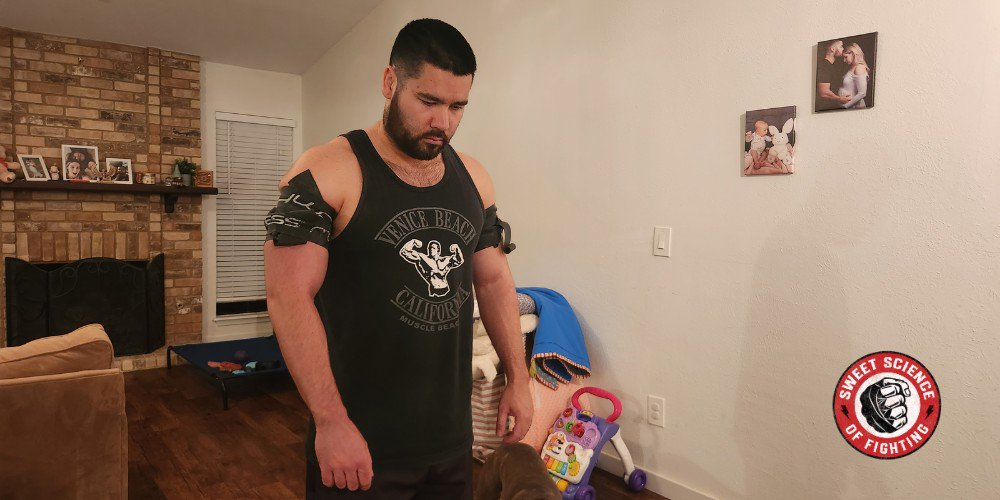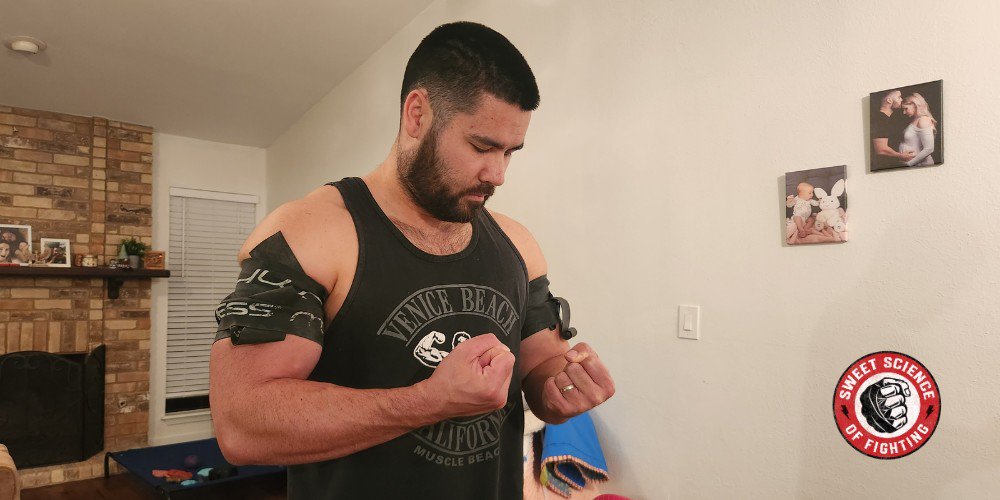Blood flow restriction training is a hidden performance enhancer no one knows about. The Egyptian international-level wrestlers have, and I’m presenting it to you so you can take advantage of this novel training method.
So, why might someone choose blood flow restriction techniques instead of traditional strength training when pursuing muscle growth and strength to transfer to wrestling and grappling?
What Is Blood Flow Restriction Training?
Occlusion training, sometimes called blood flow restriction (BFR) training, involves wrapping a band around the upper parts of the limbs, allowing blood to flow into the muscles while limiting its exit [1].
This technique traces back to the 1970s in Japan, introduced by Dr. Yoshiaki Soto under the name Kaatsu, which is why some still call it Kaatsu training. The primary goal of this approach is to foster a condition conducive to muscle growth without the necessity for heavy weights.
Interestingly, blood flow restriction techniques have been applied within specific and non-specific wrestling and jiu-jitsu training.
This is where the magic lies with occluding blood flow and combat sports.
Blood Flow Restriction Use Cases Within Wrestling

First, I’ll touch on non-specific blood flow restriction training in wrestlers and jiu-jitsu athletes. Non-specific meaning training outside of the sport. This is typically weight training targeting strength and hypertrophy.
Interestingly, the two wrestling studies investigated acute hormonal responses to different blood flow restriction protocols. I don’t know why you’d want to study this response, as it has been shown repeatedly that acute increases in anabolic hormones are not associated and do not determine increases in strength and muscle size [2][3][4].
But I digress. Study 1 found that low-intensity occlusion training is a better option than high-intensity occlusion training in youth Iranian wrestlers [5].
The low-intensity group performed the typical protocol of 4 x 30-15-15-15 at 30% 1RM, and the high-intensity group performed 3 x 10 at 75% 1RM for the biceps curl, leg extension, and bench press.
5 Step Blueprint To Build A BJJ Strength Workout To Demolish Your Opposition
Learn how to plan your strength training to maximize transfer to the mats.
The heavy load group showed increases in muscle damage markers and the stress hormone cortisol over the light load group with no differences in testosterone.
Study 2 used the same exercise protocols but with more exercises and used elite wrestlers from Golestan province with over 10 years of training experience [6].
They didn’t find anything too interesting, with no significant differences between groups for the hormones measured, but heavier-loaded groups tended to create a more anabolic environment.
However, as mentioned earlier, acute changes in hormones don’t equal chronic changes in performance.
Within jiu-jitsu athletes, high-load blood flow restriction squats at 80% 1RM to failure showed similar reductions in strength after exercise to the non-occluded group [7]. Again, this doesn’t tell us much.
The most enticing study is the only other wrestling and blood flow restriction study that used specific wrestling technical drills with the BFR cuffs in elite Egyptian wrestlers from the National team [8].
Interpreting the drills they used is challenging, but from my interpretation, sessions started with a form of clinching or over/under fighting. Then, only simple body lock lifts. The main portion were three variations of the snatch drill from the upright position.
Based on their description, this was a snap down into a body lock suplex from the side. Everything was performed for 3 x 15 at 60-75% intensity.
Wrestlers wore BFR cuffs on their upper arms during all drills for 3 sessions a week for 8 weeks. Each session was 20 minutes.
They found increased blood flow, blood volume, biceps diameter, handgrip strength, number of push-ups performed, and more wrestling techniques performed in a 1-minute test following the blood flow restriction intervention.
While there was no control group, the changes in physiology and performance are impressive, especially in elite wrestlers.
What I love about this study is it shows you can make physical performance gains using wrestling as strength and conditioning training.
Specific Blood Flow Restriction Training Protocols For Wrestling

The question becomes how you can use this within your grappling training to enhance performance. Research suggests blood flow restriction interventions lasting longer than 6 weeks show superior results than interventions lasting less than 6 weeks [9].
Therefore, doing this for at least 6 weeks, 2-3 times per week, would maximize adaptations to this type of training.
You can do something basic and easy to follow for 3 x 15 reps at submaximal intensity. It should heavily involve the arms and upper body.
Tie your cuffs at the top of your arm at a 7 out of 10 tightness. Some drills you could use are:
- Fighting for underhooks
- Body lock lifts
- Suplexes
- Mat returns from standing back control
- Double leg drills starting from the knee down position and hands on the back of your partner’s legs.
20 minutes per session, and you’re done. Could you use this in place of regular wrestling strength training? I don’t believe you could replace it but it may be a way to supplement the upper body work done in the gym or for more specific phases on training.
Also remember there are significant specific wrestling conditioning improvements from this form of training with enhanced blood flow to the arms.
In my opinion, it would be best used leading into a high-level event or season.
Other Blood Flow Restriction Training Use Cases
The main way blood flow restriction training is used within professional sport is to speed up rehabilitation from injury. Recovering from injury requires reducing the strength deficit between limbs and strengthening the injured limb.
However, structural damage and pain limit the use of heavy loads. An excellent example of occlusion training during injury rehabilitation is a case study of two Achilles tendon ruptures [10].
The first patient was limping and had limited push-off when walking 6 months after surgery. Blood flow restriction leg presses and calf raises increased calf strength and power by 522% and 4475% respectively in the injured leg after 5 weeks.
He could walk without assistance and started a running program. The second patient couldn’t run due to weakness 4 months after surgery.
He improved calf raise strength and power by 55.8% and 68.8% respectively after 6 weeks of blood flow restriction training. He was able to return to sport and running.
If you’re suffering from an injury limiting your mat time, you can build or maintain strength and muscle mass using a low-load blood flow restriction training approach.
Summary
Grappling arts like wrestling can benefit most from blood flow restriction training. Using wrestling drills with BFR cuffs, you can make physical and physiological performance gains that transfer to your wrestling.
There is no other modality that provides this stimulus on the wrestling mats.
References
1. Wortman, R. J., Brown, S. M., Savage-Elliott, I., Finley, Z. J., & Mulcahey, M. K. (2021). Blood flow restriction training for athletes: A systematic review. The American journal of sports medicine, 49(7), 1938-1944.
2. West, D. W., & Phillips, S. M. (2012). Associations of exercise-induced hormone profiles and gains in strength and hypertrophy in a large cohort after weight training. European journal of applied physiology, 112, 2693-2702.
3. Morton, R. W., Oikawa, S. Y., Wavell, C. G., Mazara, N., McGlory, C., Quadrilatero, J., … & Phillips, S. M. (2016). Neither load nor systemic hormones determine resistance training-mediated hypertrophy or strength gains in resistance-trained young men. Journal of applied physiology, 121(1), 129-138.
4. West, D. W., Burd, N. A., Tang, J. E., Moore, D. R., Staples, A. W., Holwerda, A. M., … & Phillips, S. M. (2010). Elevations in ostensibly anabolic hormones with resistance exercise enhance neither training-induced muscle hypertrophy nor strength of the elbow flexors. Journal of applied physiology, 108(1), 60-67.
5. Eslami, R., Yari, M., & Lotfi, N. (2019). Comparison of Acute Hormonal Responses to High and Low-Intensity Resistance Exercise with Blood Flow Restriction in Young Wrestlers. Annals of Military and Health Sciences Research, 17(1).
6. Lael Sadeghi, J., Habibi, H., & Amani-Shalamzari, S. (2021). Comparison of acute effects of different resistance exercise protocols with and without blood flow restriction on selected hypertrophy-related hormones in competitive wrestlers. Journal of Exercise & Organ Cross Talk, 1(2), 59-65.
7. Neto, G. R., Santos, H. H., Sousa, J. B., Júnior, A. T., Araújo, J. P., Aniceto, R. R., & Sousa, M. S. (2014). Effects of high-intensity blood flow restriction exercise on muscle fatigue. Journal of human kinetics, 41(1), 163-172.
8. Ghoraba, M., Ghazy, M., & El Tomey, M. (2017). Effect of exercise program with blood flow restriction on upper limb vasculature and performance in wrestlers. IJSSA, 2, 298-327.
9. Loenneke, J. P., Wilson, J. M., Marín, P. J., Zourdos, M. C., & Bemben, M. G. (2012). Low intensity blood flow restriction training: a meta-analysis. European journal of applied physiology, 112, 1849-1859.
10. Yow, B. G., Tennent, D. J., Dowd, T. C., Loenneke, J. P., & Owens, J. G. (2018). Blood flow restriction training after Achilles tendon rupture. The Journal of Foot and Ankle Surgery, 57(3), 635-638.

